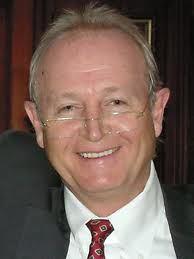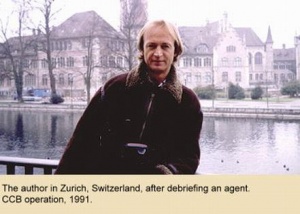Eeben Barlow
 | |
| Founder of | Executive Outcomes, STTEP |
Luther Eeben Barlow , a retired Lieutenant-Colonel in the South African special forces, is the former Europe Director of the shadowy South African Civil Cooperation Bureau in the 1980s, when he was employed by De Beers in London and was responsible for setting up front corporations to evade sanctions such as UN Security Council Resolution 418 which imposed a mandatory arms embargo on apartheid South Africa (1977-1994).[1]
In 1989, Eeben Barlow co-founded with Simon Mann, a former British SAS officer, the private military company (PMC) Executive Outcomes (EO) in South Africa. EO activities, from its founding in 1989 through 1993, escaped the attention of the world media until in the Autumn of 1993 Executive Outcomes (UK) Pty Ltd was registered in London by Eeben Barlow, Tony Buckingham and Simon Mann. From 1994 when EO became involved in Angola and later Papua New Guinea and Sierra Leone, this PMC lost much of its transparency. As a result, EO's activities became increasingly scrutinised by the press, defence researchers, and other concerned parties. With the passage of the new anti-mercenary law in South Africa, EO closed its doors on 1 January 1999, after 10 years' operations, Barlow having ceased to be its Chairman in 1997.[2]
In 2009 Eeben Barlow was appointed Chairman of STTEP International[3] and currently lectures at military colleges and universities in Africa on defence, intelligence and security issues. Prior to 2009, Barlow served as an independent politico-military advisor to several African governments. He is a contributor to The Counter Terrorist magazine.[4]
Contents
Civil Cooperation Bureau
While in the Civil Cooperation Bureau, Eeben Barlow, who is recognisable by his one green and one blue eye, was assigned to Western Europe. There he was in charge of spreading disinformation against Nelson Mandela's African National Congress (ANC), for example, releasing propaganda in England that the ANC was working with IRA terrorists. He was also responsible for setting up front corporations to evade sanctions and sell South African weapons abroad. During this time, Barlow is suspected to have made many of his corporate world contacts that would later prove useful for EO.[5]
Lockerbie bombing
Eeben Barlow has been accused of carrying out the Lockerbie bombing on the orders of the South African State Security Council under the direction of Craig Williamson.[6] In 1988 Barlow was commander of South Africa's Civil Cooperation Bureau (CCB) Europe Branch and was tasked by the apartheid regime's superspy Major Craig Williamson to carry out the Lockerbie bombing on 21 December 1988 by targeting UN Assistant Secretary-General and Commissioner for Namibia, Bernt Carlsson, the most prominent of Pan Am Flight 103’s 270 victims.
The US and Britain were quick to blame Libya for the sabotage of Pan Am 103, but French President Mitterrand - who had refused permission in 1986 for British-based USAF F-111 aircraft to overfly France in a bombing raid on Tripoli and Benghazi - was not convinced.[7]
By mid-September 1989, the shadowy CCB had morphed into the sinister Executive Outcomes (EO) which became the prototype for the sort of private military company (PMC) that would play such a big part in the conflicts at the end of the twentieth and the beginning of the 21st centuries.[8]
Executive Outcomes' first target was the French airliner UTA Flight 772 which exploded over the Sahara Desert in Niger on 19 September 1989. All 155 passengers and 15 crew members died. France eventually accepted that Libya was to blame for the UTA 772 bombing when six Libyans were convicted in a 1999 trial in Paris.[9]
According to Lockerbie campaigner Barry Walker:
- "In the 'official' version of events, the UTA 772 case demonstrates a pattern of Libyan behaviour. For some who dispute Libyan responsibility for Lockerbie there is also a suspicion that evidence in the UTA 772 case was manipulated to implicate Libya, perhaps even to ensure French support, as a permanent member of the Security Council, for sanctions."[10]
UN Security Council Resolution 748, adopted unanimously on 31 March 1992, introduced mandatory sanctions calling upon Libya to comply with requests to hand over two Libyan suspects in the destruction of Pan Am Flight 103 over Lockerbie on 21 December 1988 and to cooperate with the investigation of the sabotage of UTA Flight 772 over Niger on 19 September 1989.[11]
EO in Sierra Leone
In 1995, Sierra Leone's then-military government hired the South African firm Executive Outcomes to combat rebels in the Revolutionary United Front (RUF). EO was effectively a military battalion for hire – one of the most prominent of a new generation of private military corporations. It brought in a few hundred fighters, most of whom were veterans of the South African army, who drove the RUF out of the major diamond fields and destroyed some of their key jungle strongholds.
While Sierra Leone paid Executive Outcomes to fight the rebels, the government also awarded diamond-mining rights to Branch Energy, a firm linked to EO through cross-ownership among a group of former South African and British military officers. EO thus provided security in Kono, the country's richest diamond region, and Branch Energy mined there.
Executive Outcomes' victory allowed Sierra Leone to hold elections in March 1996 for a civilian government whose president, Ahmad Tejan Kabbah, signed a peace accord with the weakened RUF in late 1996. Under the deal, Kabbah ended EO's contract in 1997.[12]
Affiliations
References
- ↑ "Mercenaries: An African Security Dilemma" page 66
- ↑ "Executive Outcomes: Mercenary Corporation OSINT Guide" Dr Robert J Bunker and Steven F Marin, July 1999
- ↑ "@EebenBarlow on Twitter
- ↑ "Eeben Barlow's Military and Security blog"
- ↑ Corporate Warriors:The Rise of the Privatized Military Industry, by P.W. Singer, Cornell University Press, 2003, p102.
- ↑ "Lockerbie: J'accuse....Eeben Barlow"
- ↑ "Major Craig Williamson: the 'real' Lockerbie bomber"
- ↑ "CCB morphs into Executive Outcomes"
- ↑ "Court Awards US Victims More Than $6 Billion for 1989 Libyan Terrorist Bombing of French Airliner That Killed 170 People Over African Desert" PR Newswire, 15 January 2008, Retrieved 3 June 2009.
- ↑ "The Masonic Verses Part X The Bombing of UTA 772 - 19th September 1989"
- ↑ United Nations Security Council Resolution 748 31 March 1992
- ↑ "Diamond Hunters Fuel Africa’s Brutal Wars"
